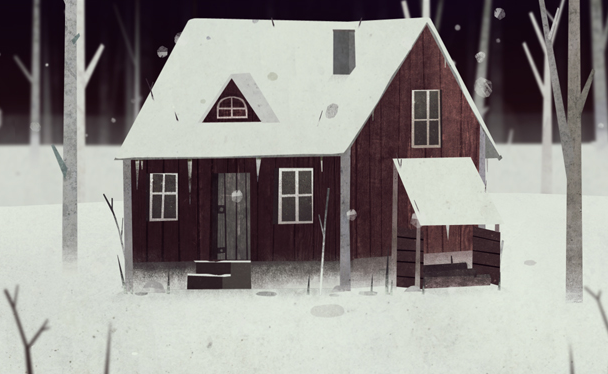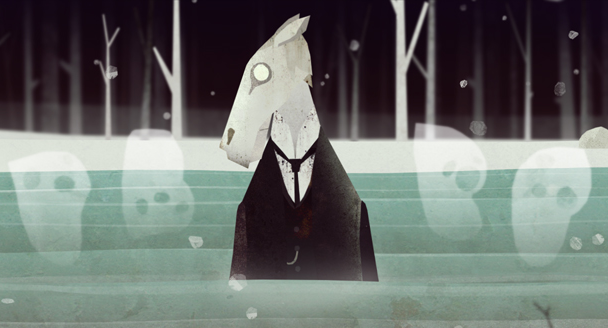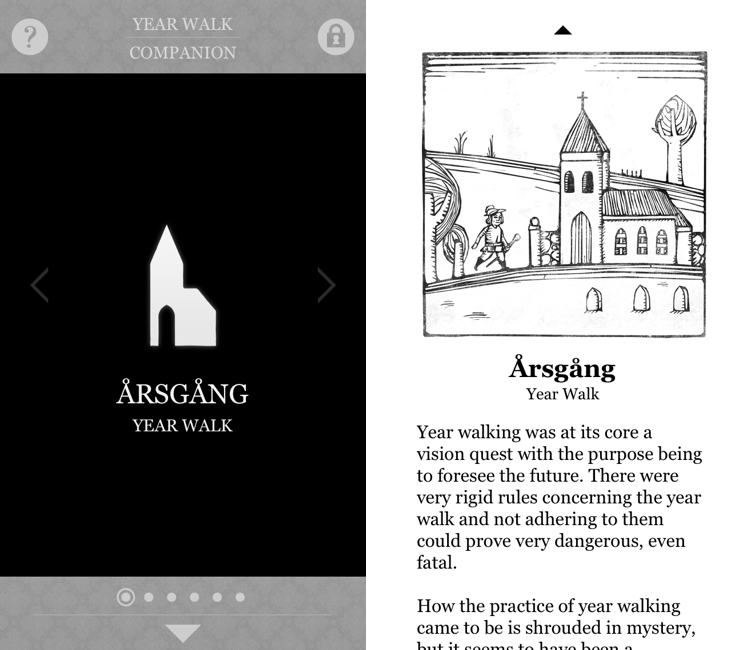Last night, I finished Year Walk – the latest game from Simogo, creators of Bumpy Road and Beat Sneak Bandit – and even if games don’t belong in my usual area of coverage here at MacStories, I think Year Walk deserves a special mention.
Calling Year Walk a “game” is actually reductive. Even though it plays like a game, Year Walk is an experience spanning various aspects of storytelling, Swedish folklore, multitouch interactions, sound, and additional reading material available in a Year Walk Companion app.
Year Walk is the most unique “game” I have played on iOS in years. I’ll try my best to describe its appeal in this post.
The premise of Year Walk lies in an ancient Swedish phenomenon called Årsgång, translated in English as Year Walk. As explained by Simogo in October 2012, the Year Walk was a sort of ritual that, according to old Swedish folkloristic stories, some people went through in the 19th century. It consisted of a “walk” around the woods at the midnight of Christmas Eve or New Year’s Eve, with no fire and food, aimed at “seeing” what would happen in the following year. A vision quest for the future, essentially.
Typically a year walk had to be done on Christmas Eve or New Year’s Eve, during the night.
Almost all variations involve having to spend a full day inside a dark room. One was not allowed to talk to anyone or have anything to eat or drink. At the stroke of midnight one should head for church. This was not an easy task as strange and dangerous creatures roamed the night. These creatures would of course include a lot of the mythical creatures from the Scandinavian folk lore.
With this in mind, Year Walk the game has been developed as a first-person “adventure” into a snowy forest with the sole purpose of reaching a vision that would show you, the “main character”, a glimpse of the future. Year Walk can be comfortably finished in 3–4 hours without reading any tips or tutorials on the Internet; more than “short”, however, I would call Year Walk’s experience as a “concentration” of gameplay ideas that Simogo applied to take advantage of the hardware Year Walk runs on.
The first-person perspective of Year Walk isn’t rendered in the usual 3D you may see in first-person shooters or role-playing games. While leveraging both 3D and 2D elements, Year Walk’s first-person lets you move horizontally and vertically in the forest by swiping on your device’s screen. There are no loading times for the various “zones” of the forest: every time you swipe vertically to move forwards/backwards, elements of an area appear in real time, becoming bigger/smaller as you swipe to reach them or go back to the previous area. The best way I can describe the visual effect of Year Walk’s engine is by comparing it to slowly opening the pages of one of those pop-up books for children. You can take a look at this YouTube video to get the idea.
In spite of its first-person perspective, you, the player, never see or hear anything of the “person” you’re controlling: there are no hands, no clothes, no visible signs of your existence in the forest aside from the fact that (few) other human characters will talk to you. Continuing their tradition of an interplay of graphics and sounds, Simogo decided to make the sound of footsteps in the snow the only element suggesting you are, in fact, a human being walking in a forest. Sounds of other physical elements (wind, rocks, wood) are superbly rendered through the iOS speakers as well.
From an artistic standpoint, Year Walk takes Simogo’s style to a new level. Year Walk employs a mix of white, brown, black, and purple/blue tones that give the forest and its surroundings a very distinctive appearance. Most of the time you’ll be looking at the screen and wondering what exactly you’re looking at: perhaps it’s a pale horse with a suit, the dead body of a crying child, or a hung wooden doll. Year Walk is creepy, mysterious, and even unsettling at some points. My suggestion is that, if you have very young kids, you probably shouldn’t let them play this game.
Being a folkloristic form of precognition, something that struck me as very peculiar is how Simogo designed the whole game to look like a dream. It’s hard to put this into words – which is why, again, I recommend you watch some trailers – but the first-person perspective also includes small white flashes and shades appearing on screeen, suggesting that what you’re “seeing” is going through the eyes of someone who’s having some sort of lucid vision. To draw another comparison with the real world, imagine if the entire scenery was passed through a damaged film with subtle scratches and altered colors.
In terms of gameplay, Year Walk consists of a combination of puzzle-solving and exploration. Walking around the forest is done with the aforementioned swipes and by looking at an indicator at the top/bottom of the screen that tells you when there’s an available path that you can follow. I wouldn’t call it backtracking considering how limited the forest is (there are probably less than 50 “screens”), but there’s a lot of necessary exploration of the same areas going on. As the player, it’s easy to get lost in the snow and trees of the forest, much like the protagonist participating in the year walk can get lost. There’s a subtle, yet profound connection between the player and the unnamed character. In order to remember some runes (which are freely inspired by Swedish folkore) I had to use my iPhone several times to write down notes and take photos.
Year Walk’s puzzles are genuinely good. They’re not, strictly speaking, “hard”, but they can be tricky if you don’t pay attention. They’ve been cleverly put together, but I believe their best quality isn’t measured in a scale of difficulty, but in the way they must be solved using various input methods that involve multitouch and sound. There’s a puzzle requiring you to tap & hold with one finger and move around with another one; there’s a section where you have to use tonal memory to guess the way forward; there’s also a puzzle that you can solve only by shaking your device. I believe it’s safe to say that Year Walk wouldn’t have been possible on any other platform – or, at least, it would have been, but with deeply altered (and possibly shallower) mechanics. Year Walk is an iOS game.
Playing Year Walk would, literally, give you just half of the story. Alongside the game, Simogo has also released a free Year Walk Companion app, which provides more details on the traditions and creatures mentioned in Year Walk. As an app, the Companion is simple and useful. Navigating the main entries is done by swiping “pages” horizontally on a main screen and then vertically to dive into reading mode. I’m a fan of this layout. However, the best part of the Companion isn’t the explanation of the creatures and Årsgång, but the section you unlock once finishing Year Walk. I don’t want to spoil anything, so I’ll just say that, like the game, that section once again blurs the line between reality and vision.
Year Walk is beautiful, unique, and immersive. Year Walk is creepy – sometimes even weird – and unlike anything I’ve played on iOS. It’s not perfect: I wish the game lasted a little longer; there were parts of the backstory that could have been revealed in the game (perhaps with additional puzzles) without having to necessarily rely on the Companion. I feel like it was a little too much concentrated overall.
Year Walk’s brevity doesn’t take anything away from its core of special, unusual experience designed around the features of iOS devices. It’s a gem well worth its $3.99 price on the App Store.




